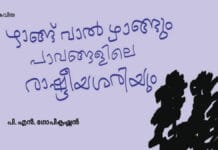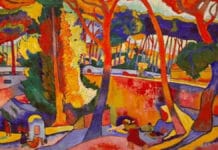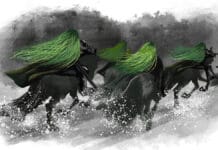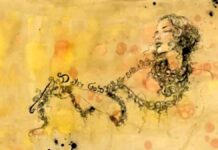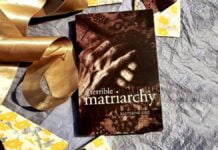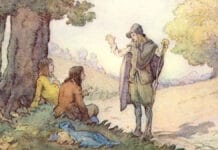Alice Oswald’s Dunt: A Poem for a Dried-Up River is a haunting, incantatory lyric that explores themes of ecological decay, mythological memory, feminine resilience, and the poetics of disappearance. Written in free verse with a fragmented, echoic structure, the poem presents the voice of a dried-up Roman water nymph who struggles to summon back the lost flow of her river. Oswald melds ecological elegy with mythopoeic imagination to produce a work that resonates deeply within the eco-poetry tradition while offering a feminist meditation on voice, survival, and spiritual absence.
Summary
The poem opens with an image of a “very small and damaged and quite dry” Roman water nymph made of bone, once the guardian of a flowing stream, now reduced to a relic. The nymph repeatedly attempts to summon a river out of limestone —a task rendered futile in the face of environmental depletion. The repeated refrain “try again” structures the poem, reinforcing the persistence and desperation of the nymph’s effort.
As the poem unfolds, the boundaries blur between the figurine, the dried river, and an aged woman wandering through an arid landscape. These shifting identities create a composite symbol of diminished power, voicelessness, and residual spiritual force. Oswald presents scenes where the old woman leans over parched grass, the church congregation is unsure whom to pray to, and the river itself is described as a once-vital entity now reduced to a fishless route.
The final sections of the poem evoke local memory —villagers recalling times of abundant rain, floods, and frozen riverbanks. Yet, these recollections only underscore the present absence. The poem ends not with renewal but with the image of a disused, nearly silent landscape—a fish path with almost no fish in.
Ecological and Mythological Dimensions
Dunt: A Poem for a Dried-Up River is an ecological elegy lamenting the disappearance of a once-living water system. The river is not merely a geographic feature but a mythic being, embodied in the figure of the nymph whose existence is tied to its vitality. Oswald reanimates the ancient belief in river deities, exposing their helplessness in the face of modern ecological collapse. The poem is thus a lament for both natural loss and cultural amnesia.
The classical image of the water nymph is recontextualised in a postmodern environmental frame, where mythology is not a source of power but of pathos. The nymph’s voice is unintelligible, her body eroded, her magic exhausted. Oswald’s fusion of pagan iconography with contemporary ecological concern reflects a loss of spiritual connection to the natural world.
Feminist and Posthumanist Readings
The poem’s protagonist —part nymph, part woman, part natural phenomenon —evokes the feminine principle associated with water, fertility, and flow. Yet here, that principle is dismembered and marginalised. Oswald aligns the drying of the river with the silencing of the female voice. The nymph is “the last known speaker of her language,” a phrase that resonates with linguistic extinction and cultural effacement.
From a posthumanist perspective, the poem dismantles human-centred narratives and suggests that non-human entities possess agency, voice, and historical memory. The dried-up river, though no longer flowing, continues to “speak” through the ghostly presence of the nymph and the sonic textures of the poem.
Form and Language
Oswald’s use of free verse and lack of punctuation creates a sense of unbroken, breathless flow, mimicking both the rush and the evaporation of water. The repetition of phrases like “try again” serves as a poetic pulse, a prayer, or a spell—an invocation to resurrect what has been lost.
The sonic landscape is rich with rustling, lapping, and whispering—all subdued, all nearly gone. This soundscape reflects the acoustic ecology of a drying world. Oswald’s diction is spare yet potent, and her use of metaphor is fluid: the nymph becomes the land, the old woman becomes the riverbed, and language becomes the medium of survival.
Intertextuality and Literary Context
Dunt: A Poem for a Dried-Up River situates itself within the traditions of pastoral elegy and mythic narrative but subverts their redemptive trajectories. Unlike conventional elegies that end in consolation or transformation, Oswald’s poem offers no catharsis. Instead, it sustains a mood of unresolved mourning.
The poem converses with classical sources—Ovidian metamorphosis, Homeric invocation—and modern literary figures like T.S.Eliot, whose The Waste Land similarly elegises a spiritually barren terrain. Oswald’s innovation lies in fusing these references with an ecological immediacy that speaks to the Anthropocene.
Oral and Ritualistic Qualities
Oswald, a poet known for her memorised and often chant-like performances imbues Dunt: A Poem for a Dried-Up River with liturgical rhythm. The poem’s repetition mimics ritual; its fragmentary, mantra-like lines evoke a priestess or shaman invoking forgotten powers. The act of reading Dunt: A Poem for a Dried-Up River aloud becomes a performative mourning, a spell of remembrance.
Dunt: A Poem for a Dried-Up River is an extraordinary work that operates across poetic, ecological, and mythological registers. It gives voice to the silent, the forgotten, and the vanishing. Through its complex layering of imagery, sound, and structure, the poem mourns not only a river but a worldview in which nature was animate, feminine, and revered. Oswald’s achievement transforms that lament into an enduring, resonant act of poetic witnessing.


